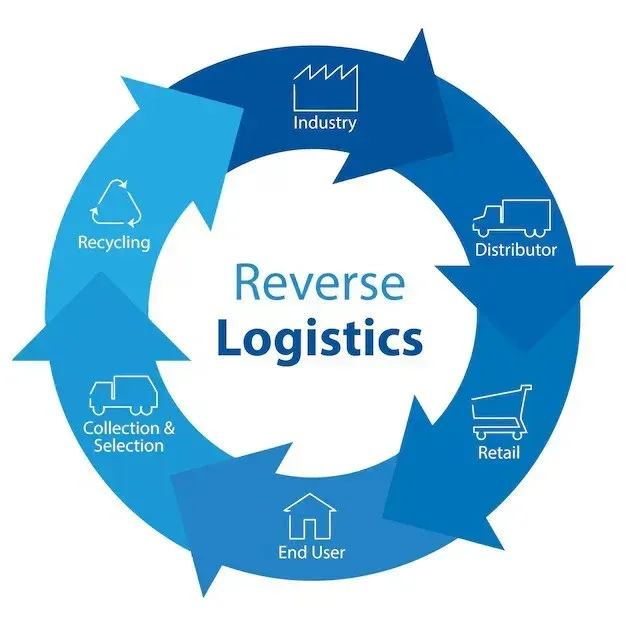What happens to products once they’ve reached their destination or completed their life cycle? At this time, reverse logistics steps are especially needed. It’s a process that focuses on managing the return, reuse, recycling, or responsible disposal of products, materials, and equipment. Return logistics goes beyond sustainability—it’s a strategic approach that can improve operational efficiency and more.
In this article, we’ll explore how reverse logistics can enhance your business operations and provide a competitive advantage. Keep reading to learn how optimizing it can develop your supply chain and drive success.
What is Reverse Logistics?
Reverse logistics occurs when products, materials, or equipment move backward in the supply chain instead of forward. Businesses use this process to return, repair, recycle, or safely dispose of items. The goal is to reduce waste, save resources, and support sustainability. Returns management also helps companies lower costs and comply with environmental regulations.
Functions of Reverse Logistics
Returns strategies follow a structured process to ensure products are handled efficiently. Here’s how it works:
1. Product Return
When customers return products, businesses must inspect and decide what to do next. Items that can be repaired may be sent for refurbishment, while others may need recycling or disposal.
2. Inspection and Sorting
Once returned, products undergo a quality check. The company then decides whether to resell, repair, recycle, or dispose of the item.
3. Refurbishment or Repair
Some items, like electronics, appliances, or IT equipment, can be fixed, upgraded, or repackaged for resale. This reduces waste and provides a cost-effective alternative to making new products.
4. Recycling and Reuse
Many materials, like plastic, metal, or electronic parts, can be recycled and used again. This helps businesses reduce waste and be more eco-friendly.
5. Safe Disposal
If a product cannot be reused or recycled, it must be disposed of properly to meet environmental laws and safety standards.
By following these steps, businesses can maximize product value while minimizing waste and costs.
Benefits of Reverse Logistics
Reverse logistics is more than just handling returns. It helps businesses save money, take care of the environment, and improve how they run. Here’s how it can benefit a company:
Protecting the Environment
Reverse supply chain helps businesses take care of the planet by recycling and reusing products. Instead of throwing things away, businesses can fix or reuse them. This helps reduce waste and pollution and makes the business more eco-friendly.
Saving Money
With returns management, businesses can save money by reusing materials and products. When companies fix or resell returned products, they don’t have to spend as much on making new ones. They also spend less on getting rid of waste because they recycle materials.
Following the Rules
There are rules about safely disposing of old products. Product return helps businesses follow these rules to avoid fines. By recycling and properly disposing of products, businesses stay on the right side of the law and show they care about the environment.
Improving Brand Reputation
Customers like businesses that care about the planet. By using reverse management to recycle and reuse, a company can demonstrate its responsibility. This helps build a strong reputation and makes customers want to stay with the business.
Gaining a Competitive Advantage
It helps businesses run more smoothly by handling returns and recycling efficiently. This makes the business better at serving customers, saves money, and helps the business grow faster than its competitors.
Optimize Your Global Supply Chain with IOR Africa
Managing reverse logistics and global supply chain challenges can be tough, but leveraging our solutions to ensure compliance with global trade laws and navigate cross-border documentation requirements makes it much easier. IOR Africa supports businesses by handling international trade regulations, maintaining compliance, and reducing risks, ensuring that cross-border operations run smoothly and efficiently.
Ready to improve your global supply chain? Fill out the form now for a consultation!
Explore related articles:
Frequently Asked Questions
What are the Three Pillars of Reverse Logistics (3Rs)?
At the core of return logistics are the “Three Rs” — Reduce, Reuse, and Recycle — which guide sustainable resource management and environmental responsibility. These interconnected principles ensure a comprehensive approach to return logistics.
- Reduce: The first step is minimizing waste and the consumption of limited resources. This can be achieved by optimizing production, adopting lean practices, and encouraging responsible consumer behavior.
- Reuse: Once products or materials have reached the end of their lifecycle, return logistics enables their reuse, whether through refurbishment, remanufacturing, or direct reuse. This reduces dependence on new materials and minimizes waste.
- Recycle: When reuse is no longer possible, return logistics helps recycle materials, converting them into new products and promoting a circular economy by keeping valuable resources in circulation.
What role does technology play in reverse logistics?
Technology plays a critical role by providing tools for tracking returns, managing inventory, analyzing data for process improvements, and automating tasks. Advanced systems and software can improve efficiency, accuracy, and overall management of reverse logistics processes.

